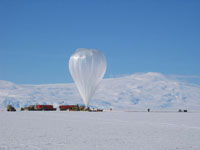Topic 2:
Detectors on Balloons
 |
| A balloon launch at McMurdo Station, Antarctica. |
| enlarge |
In order to catch CRs before they hit the Earth's atmosphere and lose their identities in the course of shattering air molecules, Seo and colleagues need to get outside the air. For practical purposes, that means at least tens of kilometers high. Even farther out would be better, but the cost of moving material to the International Space Station is very high, access is highly competitive and the station's future science role is uncertain. So experiments intended for the space station, such as the Alpha Magnetic Spectrometer, designed to search for exotic matter in CRs, must await favorable circumstances.
For results in the near term, balloons are a comparatively low-cost option. Research balloons of the sort provided by NASA and suitable for CR research are of two general types: long-duration (LD) and ultra-long-duration (ULD), both filled with helium. LD balloons typically stay aloft for as much as two or three weeks, a short enough interval that data can often be stored on board and retrieved when the balloon is recovered. Current ULD missions use a pumpkin-shaped balloon that can remain in the air for as long as 100 days. Those flights need real-time telemetry to send data to satellites which in turn relay the information to researchers.
 |
| NASA's design for a ULD balloon |
Seo has produced instruments for both, and found that each has unique challenges. In both cases, the instrument package has to be as light as possible. In the case of ULD flights, "the balloon is around 40 million cubic feet in volume, about the same as a football stadium. It can carry a weight of three metric tons, which is like three compact cars dangling on the balloon. Of course, that total includes parachutes and other equipment. For pure science instruments, we're talking about 2000 pounds."
That may sound like a lot. But it's very difficult to build lightweight equipment for this kind of job. Particle calorimeters like those on Seo's instruments detect the energy of incoming particles by measuring how deeply they penetrate into various layers of the detector and how they break up into other particles on the way. That means that the detector has to have considerable density. It also has to be large and thick enough to determine how much a particle bends in a magnetic field, which reveals the charge and is used to calculate the mass.
 |
| This diagram shows where the instrument cluster fits on the complete balloon payload. |
| enlarge |
Then there was the enclosure problem. At the altitude of the space station, around 350 km, "it's pretty 'clean' vacuum," Seo explains. "But down at CREAM altitude, about 40 km, it's a 'dirty' vacuum" filled with ionized atoms that affect the sensitive equipment. "Your high voltages are not very happy. Normally, you just put everything in a sealed container," as was done with ATIC. That wouldn't work, however, for a ULD mission with CREAM. "We built the system for 100 days. So we needed telemetry because we couldn't store all the data on board, but we wanted to make everything as light as possible. Plus over that long a time span, gas would leak from a pressurized container anyway. So we just got rid of the pressure vessel and the challenge was to make everything work in a dirty vacuum." It did, and the open-air CREAM suite performed extremely well. Back to Top
|

